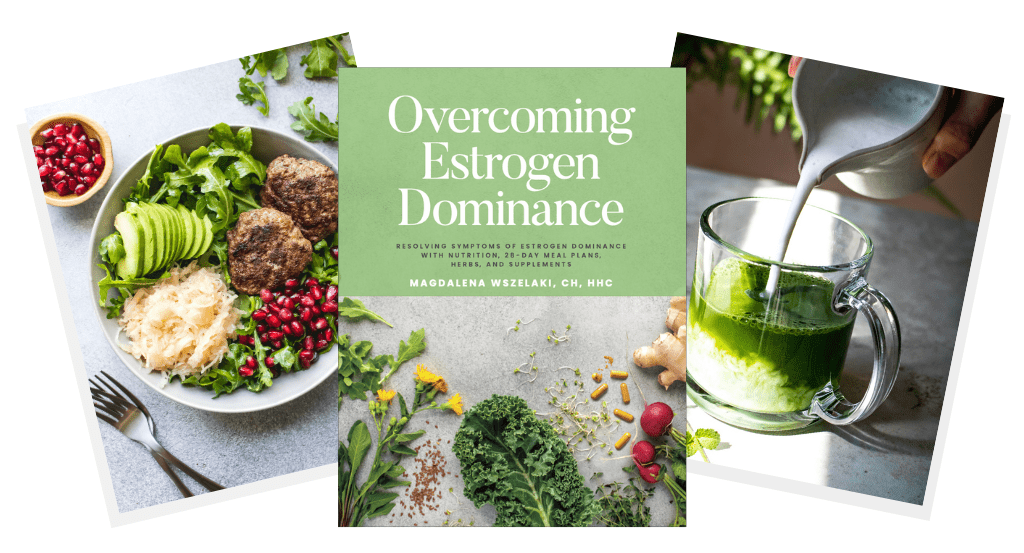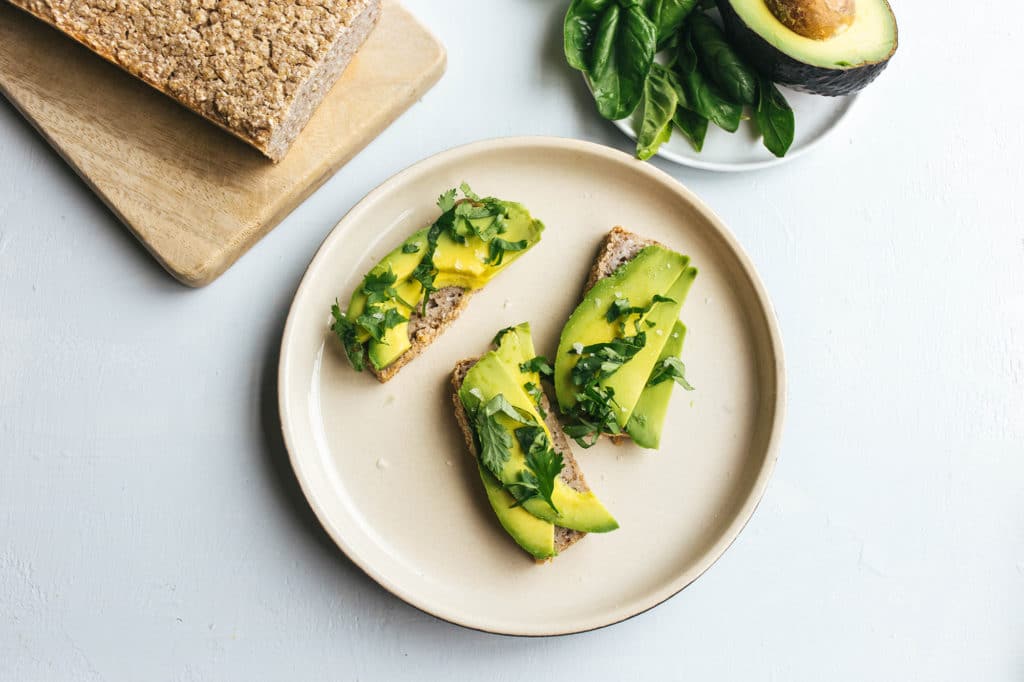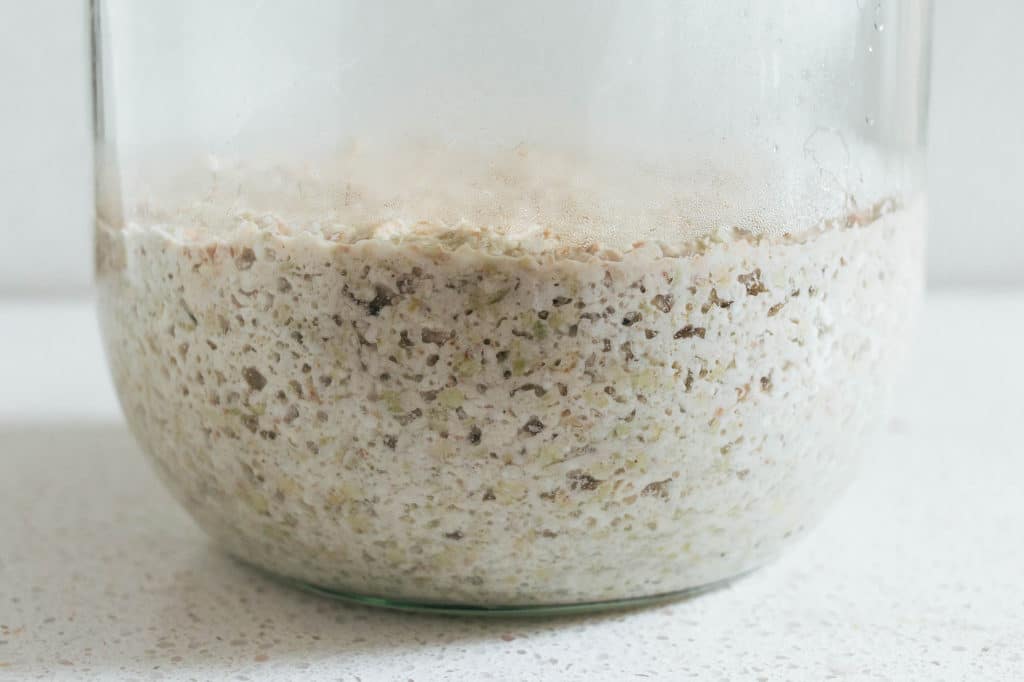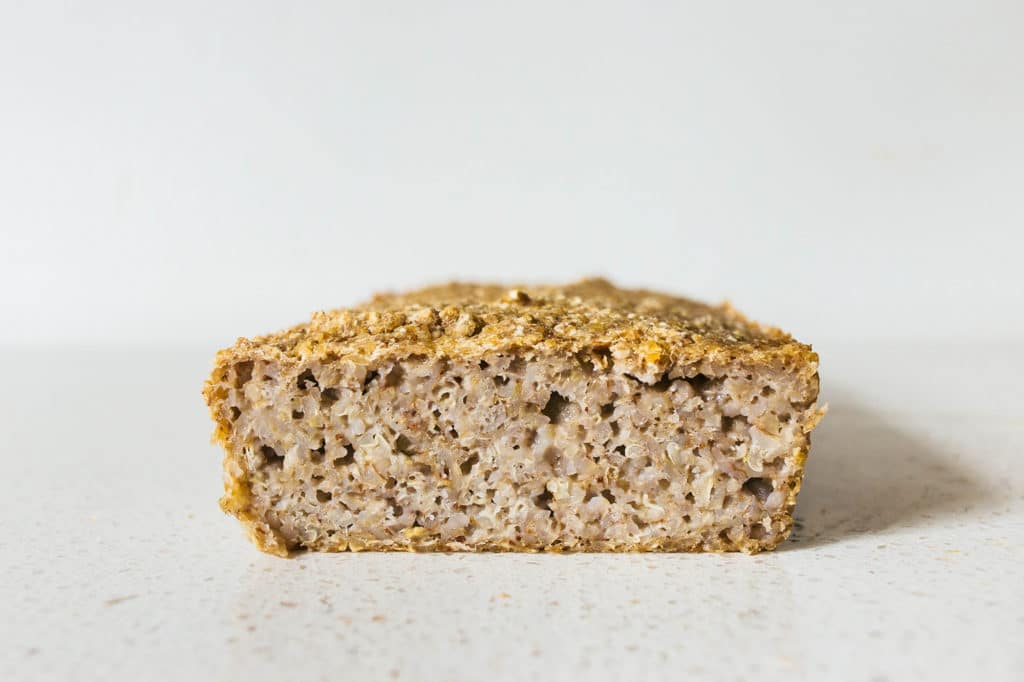Unlike most bread, this loaf contains no yeast and requires no sourdough starter.
Instead, this buckwheat-based bread uses fermentation to create a naturally leavened loaf. Fermentation offers an important gut-healing benefit – it makes it more digestible. In spite of its name, buckwheat does not contain wheat and is, therefore, free of gluten.
It contains a great deal of fiber, magnesium, and manganese.
Learn how to add more hormone-balancing ingredients to your meals with our FREE 19 Estrogen Balancing Superfoods Guide here.
- 1½ cups raw buckwheat groats (not the toasted variety known as “kasha”)
- 1¾ cups mineral water (if using filtered, be sure it contains no chloride or fluoride)
- 1¼ teaspoon sea salt
- Olive oil for greasing
- Rinse buckwheat groats under running water.
- Combine the groats and water in a large bowl. Cover the bowl with a plate or lid and let the mixture soak at room temperature for 8 hours.
- Transfer the groat mixture to a blender or food processor and pulse several times until groats and water are well combined but still coarse. Do not overblend them - or the fermentation will happen too quickly.
- Transfer this mixture back to a large bowl (I like to use Pyrex so I can see the batter), cover and let it ferment at room temperature ranging from 72F to 76F for 12 to 24 hours or until the batter becomes bubbly and slightly raises. In winter, I leave the bowl in the oven with the light on and leave the oven door ajar.
- Preheat the oven to 400F.
- Line the baking pan with parchment paper and grease with the olive oil.
- Stir the salt into the batter. Transfer the batter to the baking pan.
- Bake uncovered for 50 to 55 minutes or until the toothpick comes out clean.
- Cool the bread before slicing.
Storage instructions:
The bread can be stored in an airtight container for two days at room temperature, or up to 5 days in the fridge.

Learn more with Overcoming Estrogen Dominance
“The body has an amazing ability to heal. We just need to give it the right resources.”
In Overcoming Estrogen Dominance, my goal is to empower and give you the tools to take control of your hormones and health.
More than 70% of women experience estrogen dominance. The symptoms range from lumpy and fibrocystic breasts to thyroid nodules, hot flashes, fibroids, uterine polyps, painful, heavy or irregular periods to infertility and miscarriages, from mood swings to insomnia, weight gain to fatigue.
So many women have experienced the pain and frustration that comes when they feel their symptoms and complaints are dismissed or minimized. This is particularly true for women who are experiencing the symptoms of hormone imbalance. Even when doctors do offer treatment, it’s typically in the form of prescription medication or invasive surgical procedures.
In Overcoming Estrogen Dominance, I hope to show that those extreme interventions are often unnecessary, and to give women a roadmap to reverse estrogen dominance using food, herbs, supplements and natural protocols to rebalance hormones.
To get your copy of Overcoming Estrogen Dominance, go here.





Thanks for this recipe. As it is fermented, I am not sure whether I should make it as I am doing a protocol to remove mycotoxins from my body. This means that I must avoid anything that could contain mold. Would you be able to advise please?
Hi Gabriella,
Yes, there is some fermentation used in this recipe.
~Deanna HB Team
I tried this recipe, the bread is one of the best I’ve ever had. Thank you for posting it.
Hi Janet,
Thank you for your review of this recipe! So glad you enjoyed it! ~Deanna HB Team
Hi, I followed your instructions and after 16 hours at 76F the batter smells bad, foul. I think it gone bad 🙁 It sh0uld smell nice, right?
My batter smelled awful. I debated whether to throw it away or not. I decided to bake it. The smell was gone after the bread was done. The bread did not rise when baked (it probably should not have), the taste was OK, the bread itself was hearty and dense, no bad smell to the baked product. Its definitely different kind of bacteria (not yeast) that ferments the grain in this recipe.
Hi Irena,
Thank you for sharing your experience. ~Deanna HB Team
Hi Veronika,
It may have a slightly different smell but not foul. ~Deanna HB Team
Such tasty bread! All of us (son, daughter, husband) loved it. I know what Irina and Veronika are talking about – my batter morphed from sweet to not so sweet smelling, but it baked into a beautiful loaf. Thanks, Magdalena.
We appreciate your feedback Dawn! So happy to hear your family loved it too!
~Deanna HB Team
What kind of mineral water do you use? Is it sparkling (carbonated)?
Hi Jenifer,
Please use the non-carbonated. It is very important that there isn’t any chlorine or fluoride as it will interfere with the fermentation process. ~Deanna HB Team
I can find only sparkling mineral water, not still. I’ve tried several places AND I’m in New York City where one can find everything.
What about using spring water? Or filtered water? I have a Big Berkey. I also have a filter on my faucet. I could double filter the water.
What brand of Buckweath would you recommended?
I used spring water and I am just about to bake it. It smells nice and ferment and looks bubbly just like the picture. I fermented it for 20 hrs on top of my radiator. I will report back when its baked. Kat
Ok this bread is amazing. I let it cook for 55 mins and it was perfectly done. I’m making more now.
Thank you for improving my quality of life!
Could I double or triple recipe for a bigger loaf, thank you
Making this for the first time. I soaked the buckwheat in the water for eight hours and am ready to blend per instructions. The groats completely absorbed all the water. Should I add more after I process so there is some liquid for fermentation?
Also,, my “buckwheat groats” are brown and I see in your photo they should white? The package did not say they were roasted nor use the term kasha. What to do? Thank you!
@Kathryn Froehlich brown buckwheat is fried. That is why it absorbs the water and turns into kasha instead of fermenting. You need green one. Sometimes they write it on the pack. Or if there is nothing on the pack it should look greenish. Hope this helps.
This reminds me of those dense breads that look like bricks (yummy bricks) at the health store. They often use whole seeds to make them and the texture is moist and chewy. I’m going to try this. Thank you.
I love this recipe. It’s an all time favorite for me in a g/f world. So happy to see it again as I lost the text of it.
Is this type of fermentation ok when following anti-candida protocol? I have a similar recipe for GF teff flatbread.
Hi Lulu, Yes you can use buckwheat when on the Anti-Candida diet. It’s not a wheat it’s a seed:) ~ Jeanne HB Team
I was so excited about this recipe! I don’t know if I did something wrong but it had such a yucky taste I had to spit it out. I don’t know if I did something wrong or if that’s how it was supposed to taste?
Thank you for sharing your feedback, Katie. Did you follow the directions? ~ Jeanne HB Team
what makes it ferment? is there a leavening agent or something?
Deanna HB Team,
Thank you for this recipe! Just 2 questions:
Can I use buckwheat flour… or maybe process the groats more so it’s a finer bread?
Can this be baked in a bread machine?
Thank you in advance,
Hi Charlotte, No, you will not be able to use the buckwheat flour, but you can try processioning the groats finer. We have not tested this recipe with a bread machine. You are welcome to experiment and let us know how it works for you:) ~ Jeanne HB Team
I’ve had some toasted this morning and it was amazing! Mine close to doubled which I was very surprised at.
The only question I have is when I baked it sunk quite a bit in the middle. What could cause this and how can I hopefully prevent in the future? Thanks!
Hi Mary, I’m not sure of the cause. Maybe an uneven oven temperature. Did you open and close the oven door frequently? I hope you try again:) ~ Jeanne HB Team
WOW, I ate 3/4 of the bread right away as it was amazing!!!! wonderfull buckwheat taste. I just think there was too much salt to my taste. I am doing another one right now with less salt. Thanks so much, this is in my favorites!!!and so simple!!!!
Hi Daphnea,
I am so happy to hear that you loved this bread! Let us know how it turns out with less salt. =)
Healthy regards,
HB Team
Can you use buckwheat flour instead of the groats?
Hi Cathy!
Buckwheat groats are the hulled seeds of the buckwheat plant. In contrast, the flour is ground from the seed hulls. I am not sure that the recipe will properly ferment, when using the flour instead of groats. However, you are welcome to give it a try, and let us know how it turns out!
Healthy regards,
HB Team
[…] swap the sweet potatoes with yams. Enjoy this sweet potato butter on grain-free toast (like this sourdough buckwheat bread recipe), on top of your favorite baked goods, or straight from the […]
Hi there, after my buckwheat dough mixture sat for about 16 hours, it was bubbly but had not risen very much. Also, the outer edges had a reddish-brownish colour. Is that normal? Thanks for your help!
Hi Cindy, the bubbly is definitely normal, however the groats should have soaked up the liquid and resemble the picture above without a reddish-brown color change. Did you use a toasted variety or tap water? ~ Jeanne HB Team
[…] Sourdough Buckwheat Bread […]
I made this and love it. One question tho. Do I need to rinse the buckwheat before putting in the blender or just use the water it was soaked in to blend. I know it is important to rinse some grains. Thank you!
Hi Storm!
I am so glad you love this recipe! I prefer to rinse and then use fresh water to blend.
Healthy Regards,
HB Team
I did not see when you added the salt in the recipe? Also, what causes the fermentation? No yogurt of vinegar?
Hi Robyn,
Thank you for your question. The salt is added in step 7. As for the fermentation process, buckwheat naturally ferments when you add water and salt. It’s pretty incredible and beneficial Hope this helps. – HB Team
Hi Sarah, you’re saying in the above comment that salt is added in step 7 but you also say buckwheat ferments when you add water and salt? But the step where you add water and let the batter ferment doesn’t call for salt. Am I misunderstanding something?
Sorry for the confusion. I just meant adding salt to the process. It’s the water and buckwheat that causes the reaction. Thank you, Becky!
What is the breakdown of nutritional values?
Thank you for commenting, Franca. Our recipes focus on the nutritional benefits of the ingredients and how they can fit into a hormone-balancing meal plan. If you are tracking calories or macros, there are many excellent nutrition calculators available for free online. 🙂
– HB Team
Hi
Can you use kasha roasted buckwheat instead ?
Hi Carole. We do not recommend using kasha roasted buckwheat in this recipe.
– HB Team
Followed the recipe from the book. 2.5 cups buckwheat groats and 2.5 cups of water after rinsing buckwheat. Turns out 2.5 cups of buckwheat groats is one pound. Made twice. First time very good, yet didn’t caramelize outside crust much. Second, time let rest in pan loaf in oven with hot water for one hour. Then while dul in oven, set oven temp to 425. Baked for 90 minutes. Came our a beautiful golden brown, interior nicely finished too
Hi Thomas, it sounds like the second try worked out nicely for you! We’re glad you enjoyed the recipe. ~HB Support